The history of the Department
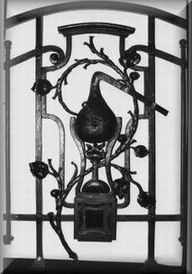
Metal-art,
side-stairs, ground floor
(year 1904)
Heads of Department of Inorganic Chemistry since 1904
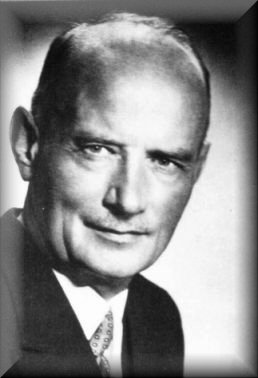
Otto Ruff (1871-1939)
Head of Department of Inorganic Chemistry, 1904-1916
- Organic chemistry
- Inorganic chemistry
- Technical electrochemistry
Born Dec. 12, 1871 in Schwabisch Hall, died Sept. 17, 1939 in Wrocław (Breslau). After finishing the humanistic high school in Hall, in 1889-91 he was trained in Stuttgart as pharmacist under supervision of the Court Counsellor Vogelen who was one of the first pharmacists in that time. Later, in 1891-1894 O. Ruff was working as pharmacist trainee in Cuvet (French Switzerland), Hamburg, Berlin and London. In 1894-1897 he studied chemistry at the Berlin University where he associated with Emil Fischer Laboratory. In 1896 he passed the state examination and became entitled pharmacist and in 1897 he received his philosophy doctor's degree at the Berlin University (under the direction of Oskar Piloty, former student and co-worker of E. Fischer). Since his sophomore year O. Ruff was a volunteer in Fischer laboratory and then a younger assistant. His duty was to supervise the Department of Analytical and Inorganic Chemistry because of lack of inorganic chemists at that time. After receiving his doctor's degree O. Ruff became full-time assistant and collaborated with E. Fischer who granted him a significant independence. In 1901 O. Ruff completed his habilitation work titled “Synthesis of sugars: novel method of aldoses degradation”.
Ruff's method of aldoses degradation was the significant contribution to research on sugars conducted by E. Fischer who was awarded the Nobel Prize in chemistry in 1902. The habilitation work of O. Ruff was published as textbook for chemistry students. After his habilitation he was promoted to senior assistant position.
The persistent lack of inorganic chemists at European universities was the reason why E. Fischer decided to send his two outstanding alumni to perfect their inorganic chemistry knowledge: Alfred Stock went to Moissan Laboratory in Paris and Otto Ruff went to Ostwald Laboratory in Leipzig. After that training, in 1903 O. Ruff was promoted to associate professor position and supervisor of Department of Chemistry at Berlin University.
In 1902-1904 O. Ruff collaborated with Albert Carsten, the chief architect of chemistry buildings at the new Technical University in Gdansk. O. Ruff designed the interior and fundamental equipment of Chemistry Building. In 1904-1916, as full professor, he was head of the Department of Inorganic Chemistry and was dean of the Chemical Faculty in years 1906/07, 1908/09, 1911/12, 1913/14, 1914/15 and 1915/16.
In 1916 O. Ruff left Gdansk and moved to Wroclaw where he was full professor until 1939 and from 1933 he kept the same position in the Department of Philosophy at the Fryderyk Wilhelm Silesian University. He decided to leave Gdansk because of persistent shortage of energy supply and electric power in the Chemistry Building what made his research impossible. While leaving Gdansk he recommended Hans von Wartenberg from Berlin for his position. During his stay in Wroclaw O.Ruff collaborated intensively with Silesian industry and was longtime chairman of the Silesian Branch of German Chemists Association and in 1933-35 he was vice-chairman of German Chemical Society.
Scientific achievements of O. Ruff are both enormous and diverse. He published 290 papers and two books [3]. During his stay in Berlin he published 35 papers, in Gdansk – 95 papers and in Wroclaw – 162 papers. The most efficient year was 1911 when he published 19 original papers. Most of his published papers appeared in: Zeitschrift für anorganische und allgemeine Chemie (113), Chemische Berichte (82), Angewandte Chemie (18), Zeitschrift für Elektrochemie (14). His main research interests were: organic chemistry of sugars (17), inorganic chemistry of fluorine (86), high temperature chemistry (44), electrolysis of molten salts (9), plastics (10), carbides (20), carbon allotropes (20), CO2 explosions in mines (7), other fields of inorganic chemistry (72). Ruff's book “The Chemistry of Fluorine” was published in 1920 by Springer Verlag in Berlin. After Moissan's death (1907) O. Ruff was worldwide recognized as an authority in chemistry of fluorine and high temperature chemistry. The way how Moissan and Ruff conducted their research was similar as well as their mentality. The second Ruff's book was titled “Introduction to Chemical Practicum” (Leipzig 1926, II ed. 1937). O. Ruff was enthusiastic and gifted experimentator. His professional activity resulted from curiosity and his hunger for knowledge and achievements in chemistry.
Honours: Liebig Medal, Military Cross of Merit, honorary doctorate of Dresden Technical University for “versatile and effective research in chemistry”, memberships of the Academy of Science in Halle and Madrid and membership of the Scientific Society in Göttingen.
Special events and interesting facts:
Beside Arrhenius (1859-1927, Nobel Prize 1903), Moissan (1852-1907, Nobel Prize 1906) and Werner (1866-1919, Nobel Prize 1913) O. Ruff was regarded as creator of renaissance of inorganic chemistry in first two decades of XX century. It was amazing that having significant achievements in organic chemistry O. Ruff allowed himself to be switched to inorganic chemistry under the influence of E. Fischer who was the highest authority for him.
During Ruff"s stay in Gdansk three interesting facts were worthwhile:
- His collaboration with A. Carsten regarding the interior design and basic equipment of the Chemistry Building. His article [1] from 1905 included detailed descriptions of all arrangements, furniture and apparatus, design of all three storeys, the use of all rooms and facilities. The photo of functional demonstration table in the Chemistry Auditorium was also included.
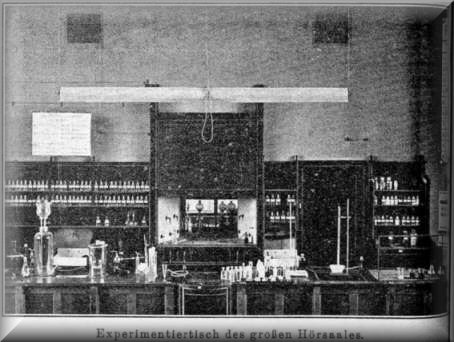
Demonstration table in Chemistry Auditorium [1]
- O. Ruff delivered invited lectures for Gdansk Nature Society and published 7 papers in its journal.
- O. Ruff wrote also technological studies on production of high temperature resistant ceramic vessels made of East Prussia clays. Some of these products were presented at Ceramics Exhibition in Olsztyn and were prized with gold medal.
There was an interesting finding in the records of Wroclaw University archives: the album of Faculty of Philosophy with the hand-written biographies of professors. Despite the fact that documents were written in Gothic what made them difficult to read, the Ruff's biography shed some light on his personality.
The scientific achievements of O. Ruff were described in many chemistry textbooks, especially his works on synthesis and properties of fluorides e.g. AgF2.
The organic chemistry books (e.g. Nenitescu, Morrisson & Boyd) quote the “Ruff's Reaction” which has many useful applications in synthesis and configuration correlations of aldoses. This reaction is also mentioned on organic chemistry website.
Obtained and tested by O. Ruff the uranium hexafluoride UF6 turned to be very crucial for XX century civilization. Its extremely high volatility (b.p. 57°C) was used for separation of 235U and 238U isotopes. This method was very essential for the construction of first atomic bombs within the Manhattan Project in 1945 [2].
O. Ruff had a nickname the molecules pastor given to him by the students. It was due to his lectures structure and a very inspired way of giving the speech what reminded the typical preaching. The nickname wandered with him from Gdansk to Wroclaw. Moreover, it is known from Ruff's lineage that there were few pastors in his mother's family.
Sources: Walter Huckel [3], Wilhelm Klemm [5], Otto Ruff [7] and other sources [4].
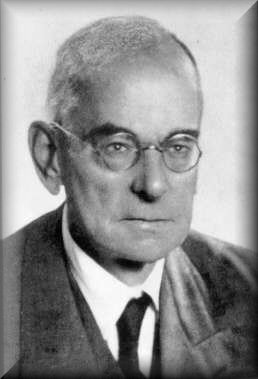
Hans von Wartenberg (1880-1960)
Head of Department of Inorganic Chemistry, 1918-1933
- Physical chemistry
- Inorganic chemistry
- High temperature chemistry
He was born in Kellinghusen (Schleswig-Holstein) and finished the high school there. Then in 1899-1902 he studied chemistry at the Faculty of Natural Sciences of Berlin University. After six semesters (!!!) H. Wartenberg received his philosophy doctorate degree based on dissertation “Contribution to the chemistry of mercury oxyhalides”. With respect to his interests in physical chemistry he became the scientific associate of Walter Nernst the director of newly founded Physical Chemistry Institute at Göttingen University. W. Nernst (1864-1941, Nobel Prize 1920) was one of four physical chemistry pioneers beside Ostwald (1853-1932, Nobel Prize 1909), Arrhenius (1859-1927, Nobel Prize 1903) and Van't Hoff(1852-1911, Nobel Prize 1901). In 1905 W. Nernst was invited by Max Planck and became the head of Department of Physical Chemistry at Berlin University. H. Wartenberg followed him and initially started his work as assistant and then, after completing his habilitation (1908), he was promoted to associate professor position (1910). Following the invitation of Prof. A. Wohl, the Rector of Technical University of Gdansk, H. Wartenberg moved to Gdansk and starting from Oct. 1, 1913 he lectured physical chemistry and later also inorganic chemistry as well as inorganic technology and electrochemistry. In 1918 he became full professor and head of the Department of Inorganic Chemistry. Two times he served as the Dean of Faculty of Chemistry (1919/20 and 1923/24) and represented the Faculty of General Sciences in the University Senate. In 1933 H. Wartenberg returned to Gottingen where he replaced Zsigmondy (Nobel Prize, 1925) as full professor and director of the Institute of Inorganic Chemistry. First, thanks to money from Rockefeller Foundation he renovated and extended the institute and started intensive research. In 1937 he was forced to retire on the basis of the racist legislation because his wife was Jewish! Further research he conducted in Institute of Physics by the courtesy of Prof. W. R. Pohl. Despite of very primitive conditions he published significant papers every year. In 1945 he was reinstated with honours to the previous position which he lost because of political reasons. H. Wartenberg retired in 1948 but he still worked experimentally to his dying day. He died in Gottingen on Oct. 4, 1960.
Scientific achievements: about 150 published papers. H. Wartenberg conducted very difficult thermochemical experiments measuring the heat of formation and atomization energy of molecules of water, oxygen, acetylene, carbon dioxide and others. E.g. water molecules were investigated at temperatures 1000-2000°C and oxygen at 1100-1150°C. He found that thermal dissociation of oxygen led to ozone formation. Working on fluorine chemistry he synthesized several fluorides e.g. PbF4, CeF4, BiF4, CrF3, CrF4, CrF5, which were impossible to obtain until then. In research on high temperature chemistry Wartenberg measured the melting point of platinum, palladium, tungsten, thorium, and boiling point of silver and chromium using the volatility measurements; he determined the temperature of thermite reaction (24000°C), Langmuir flame temperature (47000°C); in order to define the type of molecules in gas phase he measured the vapor density for lead, silver, antimony, bismuth, sulfur, selenium, intermetallic compounds (MnZn2, Na3Hg) and even salts: he also found that some fluorides dimerize in gas phase what was later confirmed by mass spectrometry. He invented also the method for reduction of very stable metal oxides (e.g. ThO2) by using hydrogen in high temperature and designed special ovens for that purpose.
H. Wartenberg solved also complicated technical problems. Being 70 years old he started to work on alternative methods of production of pure silicon (crystallization from metals, thermite reaction). Due to huge demand for silicon for electronic applications he founded private company producing silicon.
H. Wartenberg was highly regarded as pioneer of high temperature chemistry and his work made unquestionable impact on its further development.
Honours: 1917 – Iron Cross II class., 1952 – honorary doctorate of RWTH Aachen, Bunsen Medal, Gauss-Weber Medal.
Special events and interesting facts:
After 1920 he rejected the proposition of professorship at Polytechnic in Hannover because he thought highly of relationships and working conditions in Gdansk.
In 1937, when he was threatened by compulsory retirement because his wife was not of Aryan descent, the authorities suggested him to divorce in order to retain the academic position. H. Wartenberg has rejected!
Sources: J. Goubeau [9], O. Glemser [10], collective paper [5] p. 165, Wartenberg files from 1913-1933 nos.988/606 and 988/606 (State Archives in Gdansk).
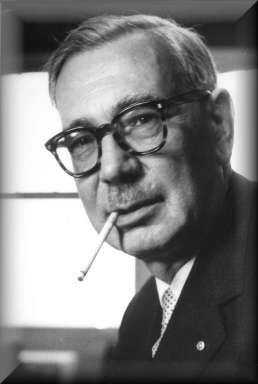
Wilhelm Klemm (1896-1985)
Head of Department of Inorganic Chemistry, 1933-1945
- Inorganic chemistry
- Nestor of solid state inorganic chemistry
- Creator of magnetochemistry
W. Klemm was born in Guhrau on Jan. 5, 1896 and died in Gdansk on Oct.24, 1985 (Guhrau is former and present Polish town Gora in Lower Silesia. Between WW I and WW II Guhrau was situated in Germany close to Polish-German border). In 1919-1923 he studied chemistry at Breslau University. In 1923 he received his philosophy doctor's degree for research on chemistry of uric acid (promotor H. Biltz). Then he was assistant in Biltz's Laboratory in Hannover and in 1927 he completed his habilitation work on inorganic chemistry. In 1929 he was promoted to the associate professor position at Polytechnic in Hannover.
In 1933-1945 W. Klemm was full professor and head of Department of Inorganic Chemistry at Technical University of Gdansk. During 1944-1945 he was last vice-rector of this German university and he was responsible for the evacuation of documentation, equipment, library and staff.
In 1947-1951 W. Klemm was professor and head of the Department of Inorganic Chemistry at the University of Cologne and later, in 1951-1964 he held the same position at the University of Munster. In 1952-1953 he was the President of German Chemical Society, in 1955-56 the dean of the Faculty of Mathematics and Nature Sciences and in 1957-58 the Rector of the University of Munster. In 1964 he retired (with the title of Honourable Senator of the University of Munster) and in 19665-67 he was the President of IUPAC (International Union of Pure & Applied Chemistry as the first German scientist after WW II.
Scientific achievements: The list of published papers of W. Klemm [10] has 250 positions including 9 books. One of them is a popular textbook of inorganic chemistry which had 40 editions, second – the textbook of preparative inorganic chemistry. Its first edition was worked out by H. Biltz and the next 40 editions with significant participation of Klemm. The book “Magnetochemistry” was published in 1936 by Klemm who was the leader in this field.
In 1944 the publishing house Ann Arbor (USA) printed two Klemm's books: “Magnetochemistry” and “Solid State Space Chemistry”. The order placed by British and American institutions induced Klemm to write the review “Analytical Chemistry in Germany in 1936-1946”. As many as 30 papers were prepared by him in the form of monograph and published mostly in Angewandte Chemie, Zeitschrift für Physikalische Chemie and Zeitschrift für Naturforschung. Most of his papers (over 200) had original character and 140 appeared in Zeitschrift für anorganische und allgemeine Chemie.
The Klemm's research was almost completely connected with the inorganic and physical chemistry. For the first time he has obtained many high purity inorganic compounds. He made the very precise measurements of their physical properties: density at different temperatures, expansion coefficients, heat of formation, electric conductivity of molten compounds, magnetic properties, crystal structure using X-ray diffraction, molar volumes and others. The results gave him insight into the character of chemical bonding. He created the widely accepted classification of rare earth metals and transition metals. Klemm obtained and studied dozens of intermetallic systems; in chemical literature one can find the Zintl-Klemm conception explaining the structure of intermetallic phases. He synthesized also scores of fluorides especially the complex ones. He was the author of many new preparative methods which found the practical applications. The best period in research activities was during his stay in Gdansk (e.g. in 1939 he published 24 papers).
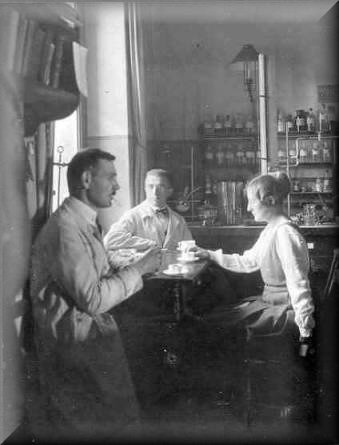
W. Klemm (left) with wife and brother-in-law in laboratory (W. Wojnowski archive)
W. Klemm promoted over 100 doctors. Many of them became professors or chemical industry specialists. The credit for post-war, considerable development of solid state chemistry in Germany went inevitably to the group of professors which were Klemm's alumni. W Klemm was the long-term editor-in-chief of two significant chemical journals (Z. anorg. allg. Chemie and Chem. Zentralblatt).
Honours: Iron Cross I class and other honours from WW I, the Great Cross of Merit of Federal Republic of Germany, Medal of Merit, honorary doctorates of Polytechnic in Darmstadt, University of Bordeaux, University of Dijon, University of Lille, Memberships of Academy of Sciences in Halle, Munich, Dusseldorf and Gottingen. Special honours included also Liebig Medal, Moissan Medal, honorary memberships of many scientific societies. University of Munster awarded Klemm the title of Honourable Senator and City of Munster gave one of the streets the name of W. Klemm. The collaboration of Polish and German Chemical Societies gave the rise to initiative of invited Maria Skłodowska-Curie/Wilhelm Klemm joint lectures. The first Polish scientist invited by German side was Prof. M. Mąkosza (1995).
Special events and interesting facts:
W. Klemm has written the History of Faculty of Chemistry of Technical University (1904-1945) which was the very important source of information about the then Faculty.
The portrait of W. Klemm hangs in the seminar room of present Department of Inorganic Chemistry together with portraits of all other heads. W. Klemm's wife, Dr. Lisabeth Klemm, worked with him in the Dep. of Inorg. Chem.
In 1984 W. Klemm gave 180 volumes of Gmelin Handbook of Inorganic Chemistry to The Library of Faculty of Chemistry as a gift. The letter connected with that had a conclusion very unusual for “iron curtain” time: “this present should express my sincere wishes to develop the good relationships between Technical University of Gdansk and German universities which should help to maintain friendly relations between our nations”.
Klemm's visit to Gdansk in 1985 had a very unexpected course. Since many years Prof. W. Wojnowski collected information about his famous predecessor, he met also several Klemm's alumni and was impressed by attachment and respect for their Master. In 1981, during meeting with W. Klemm Prof. W. Wojnowski was fascinated by his interest in our University. Despite the unfavourable political conditions at that time, W. Klemm expressed the desire to visit the Technical University of Gdansk and his former department (“Jetzt aber muss ich nach Danzig”). The 40 anniversary of our university was the good opportunity for that and W. Klemm was invited by the Rector of Technical University of Gdansk. 89-years old W. Klemm came to Gdansk, visited the faculty and the department, talked to the scientists and took part in solemn session of University Senate where Prof. Hagenmuller from France was honoured with doctor honoris causa title. Following the session the Rector of Technical University decorated W. Klemm with a commemorative medal no. 467. While thanking for this distinction Klemm said: “it is my desire to make transmission between good collaboration of scientists and better understanding of both nations”. Next day he attended the lecture of his former student Prof. von Schnering that took place in historic Chemistry Auditorium where W. Klemm used to lecture over 12 years. Later he said that he would rather stay in Gdansk instead of returning to Germany. And so... on Oct. 24 he died unexpectedly of heart attack.
The funeral was in Munster on Nov. 7. The obituary was saying: “After fulfillment of his scientific desire, W. Klemm died on Oct. 24, 1985 in Gdansk, in the city where he conducted the long-term research and was decorated with the Medal of Technical University of Gdansk”.
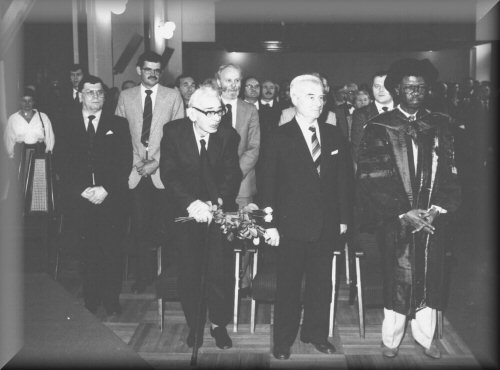
Profesor Wilhelm Klemm uczestniczy w uroczystej sesji Senatu Politechniki Gdańskiej w dniu 22 X 1985 roku (fot. T. Chmielowiec).
Sources: R. O. Oesper [12], J. Goubeau [13], R. Hoppe [14], A. Butenandt [8] and collective work [6, p. 145 ].
by Teresa Sokołowska & Wiesław Wojnowski
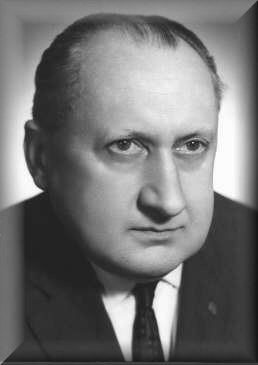
Włodzimierz Rodziewicz (1908-1976)
Head of Department of Inorganic Chemistry, 1945-1976
- Inorganic chemistry
- Nestor of organosilicon chemistry in Poland
He was born in Rożyszcze (Łuck district, Volhynia) on Aug. 7, 1909 and attended high school there. W. Rodziewicz studied chemistry at the Technical University of Warsaw (Warsaw Polytechnic), from which he graduated in 1934. A developing interest in chemistry led him to take up a post as an assistant in the Department of Inorganic Chemistry, which was headed by Prof. Tadeusz Miłobędzki – the author of superb and very popular book on analytical chemistry which was used by few generation of chemists.
W. Rodziewicz received training for X-ray physics in the Department of Physics at Warsaw University under the guidance of Prof. S. Pieńkowski and Prof. A. Sołtan. During WW II he worked in Łuck – first as a worker in a mill, then as a lab assistant and lab manager.
In July 1945 W. Rodziewicz arrived to Gdansk as a member of another operational group of scientists to start the rebuilding and reactivation of the technical university. He was one of the first co-organizers of the Faculty of Chemistry. He formed the Department of Inorganic Chemistry and became its first head after WW II and the fourth one in the history of this department. His famous predecessors were: Otto Ruff, Hans von Wartenberg and Wilhelm Klemm.
He received doctor's degree in technical sciences in 1949. His dissertation was on mixed chromium oxides. In 1950 he was promoted to the post of associate professor and from 1963 he was full professor.
W. Rodziewicz held several academic positions: he was the first post-war vice-Dean of the Faculty of Chemistry (1945-48 and 1950-51) and three-time the Dean (1951-53, 1958-60, 1960-62). From 1969 to 1974 he was the Director of the Institute of Inorganic Chemistry and Technology. Worth mentioning was his activity as editor-in-chief of the Technical University textbooks. Due to the fact that during first post-war years one could observe the noticeable shortage of academic staff, W. Rodziewicz organized and headed the Deparment of Inorganic and Analytical Chemistry at Medicine Academy in Gdansk (1945-50). He gave lectures 24 hours a week at both universities and helped to teach new assistants in the laboratories. More than 6000 students attended his lectures on inorganic chemistry, general chemistry, technical chemistry, analytical chemistry (qualitative and quantitative). Most of them he examined personally. He promoted many MSc Eng. graduates and 17 doctors. He was also the special promotor of Prof. M. G. Voronkov for doctor honoris causa title. M. G. Voronkov was world-famous organosilicon chemist and the director of Siberian Branch of the Soviet Union Academy of Sciences. Seven of the doctors promoted by W. Rodziewicz became the full professors lately.
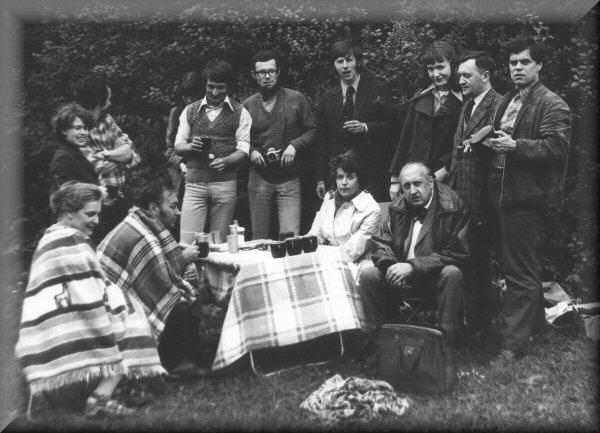
Picnic in the Kaszuby region (May 26, 1975). The members of Organosilicon Group celebrate the conferment the doctor honoris causa title on Prof. M. G. Voronkov: (sitting from left) M. Wojnowska, Prof. M. G. Voronkov, Mrs. L. Voronkov, Prof. W. Rodziewicz, (standing from left) B. Becker, S. Konieczny, E. Felcyn, A. Herman, K. Przyjemska, K. Grzędzicki and W. Wojnowski.
W. Rodziewicz was the co-author of 49 papers including 29 on new field of organosilicon chemistry as well as 4 patents, 2 editorials and 8 reviews on books and monographs.
The last decades of XX century were often called the Silicon Age due to silicon-based computation-revolution. Also the other organosilicon compounds (silicones) played important role as advanced materials and gave the field of materials much of its present momentum. E.g. it is interesting fact that the first human being on the moon used the special boots with the silicon-made sole. The fast development of organosilicon chemistry took only place after WW II and W. Rodziewicz was one of the first precursors in this field, and undisputable the first one in Poland. He laid the foundations of silicon chemistry which was then developed also in Lodz, Warsaw and Poznan. He wrote many papers and promoted 11 Masters of Science and 12 doctors, and was the editor-in-chief of the first Polish monograph “Organosilicon Chemistry” written by T. Jasiński.
W. Rodziewicz had a reputation for his sense of humor and some of his jokes stood longtime in the students memory. E.g. during the lecture on properties of acids and bases he explained how to easily remember the indicators color: “phenolphthalein is like a girl – it basically reddens (in bases)”. If he felt that the audience reacted to his words, he used to say: “once if a girl was ashamed, she reddened – nowadays girls are ashamed when they redden!”. While the audience burst out laughing, he remained poker-faced.
He was dedicated fan of the football club “Lechia”. The students used to say that if “Lechia” lost its game on Sunday, Monday was a very bad day for meeting Prof. Rodziewicz.
He liked to play bridge occasionally. The students talked about very humorous event concerning that: „Once he played bridge in his friend's, Prof. Wawryk, house which was located only one block away. The game dragged on quite long, and Mrs. Wawryk offered him to stay for the night in their house because it was raining. He agreed and disappeared for while. After few minutes somebody rang the door-bell – it was Prof. Rodziewicz, wet with the rain, holding a small bundle. The amazed hosts were told that he had to go home and to bring his pajamas!!!”.
Prof. Rodziewicz was very popular with the students. He knew the full names of all students and he used to monitor their progress all the time. Prof. Rodziewicz died on March 8, 1976. His funeral at the Srebrzysko Cemetary was attended by unprecedented number of students. He remains in our memory as a competent, honest and modest teacher. He was my Master.
by Wiesław Wojnowski
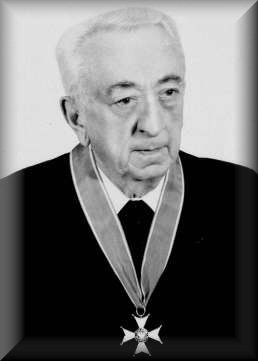
Jan Dobrowolski (1919-1998)
Head of Department of Inorganic Chemistry, 1976-1989
- Inorganic chemistry
- Chemistry of tellurium
- Rare earth elements chemistry
Jan Dobrowolski was born in Tarnow on July 13, 1919. He started to attend high school in Ostrowiec Swietokrzyski and continued his education in high school in Tarnow where his family moved to. From 1938-1939 he studied chemistry at the Lwow Polytechnic (two years). The WW II interrupted his studies and he was forced to work for German occupier.
In 1941 J. Dobrowolski was arrested by Gestapo for resistance activities and imprisoned in Auschwitz concentration camp and later transferred to Mauthausen concentration camp. In 1945, after liberating the camp by American army, he returned to Poland and worked as a civil servant in Repatriation Office in Gdansk.
In 1946 he decided to continue his academic education and studied chemistry at Technical University of Gdansk. After graduation he was an assistant in the Department of Inorganic Chemistry and later was promoted to a lecturer position. In meantime, J. Dobrowolski additionally taught chemistry at Pedagogic College and at Medicine Academy and helped to organize the Departments of Inorganic Chemistry there.
From 1954-1955 he was in Vietnam as a Polish delegate to the International Supervisory Commission. In 1961 he earned a doctoral degree in chemistry for research on chemistry of tellurium (promotor W. Rodziewicz). Then he spent one year as a postdoctoral research associate at L'Ecole Superieure de Physique et Chimie Industrielles in Paris and at Paris University (with Prof. J. Amiel). In 1966 he completed his habilitation work titled “Study on halogenocomplexes of four-valence tellurium”. In 1972 J. Dobrowolski was promoted to the post of associate professor and from 1982 he was full professor.
His research interests included chemistry of tellurium, analysis of high purity materials, chemistry of rare earth metals and coinage metals. It is worth-while to mention his involvement in co-operation with industry and designing several technological processes.
The co-author of nine textbooks for students, he was also regarded as a one of the best lecturers. He promoted many MSc Eng. graduates and 11 doctors. J. Dobrowolski held several academic positions: Head of Department of General Chemistry (1967-1976), V-ce Director of Institute of Inorganic Chemistry & Technology (1974-1980), Head of Department of Inorganic Chemistry (1976-1989) and Dean of the Faculty of Chemistry (1981-1984). The member of several scientific societies, he helped to organize national and international scientific conferences. J. Dobrowolski retired in 1989. He died on Jan. 25, 1998 in Gdansk.
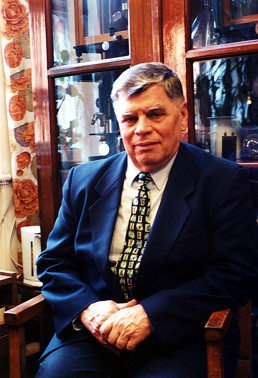
Wiesław Wojnowski (1933)
Head of Department of Inorganic Chemistry, 1989-2003
- Inorganic chemistry
- Chemistry of silicon-organic compounds
- X-ray structural analysis
I was born on March 7, 1933 in Toruń, Poland. I graduated from High School in 1952 and in the same year I started my studies in the Chemistry Department, Technical University in Gdansk, specializing in the field of organosilicon chemistry. I graduated from that University in 1957 with the degree of MSc in chemistry and chemical engineering. Directly after my graduation I started research and teaching at the Institute of Inorganic Chemistry, Technical University of Gdansk. From 1956 to 1962 I held the positions of Teaching and Research Assistant and Senior Assistant.
From the beginning of my research work, I have been specializing in the field of organometallic chemistry, especially organosilicon chemistry. In 1962 I received a PhD degree (in chemistry) on the basis of my doctoral thesis: “Study of the Alcoholysis Reactions – Ethoxycresoxysilanes” (thesis director Prof. W. Rodziewicz) and the position of Lecturer-Associate (research and teaching). In 1971, on the basis of my habilitation thesis: “Study of Alcoholysis Reaction of Silicon Disulfide”, I received a DSc degree (Doctor Habilitatus) in chemistry and the position of Assistant Professor (Docent). From September 1975 until October 1976 I worked in the field of organosilicon chemistry with Professor Robert West at the University of Wisconsin at Madison, WI USA, Department of Chemistry, as a Research Associate. In 1979 the Faculty Council of the Chemistry Department and the Senate of the Technical University in Gdansk, Poland nominated me for the position of Associate Professor and in 1987 for the position of ordinary Professor. During the spring of 1980 I served as visiting Professor in the Department of Chemistry and Biochemistry at Southern Illinois University at Carbondale (USA) and during the spring of 1981 – as visiting Professor at the Department of Inorganic Chemistry at the University in Gottingen (Germany). Since December 1983 I was a visiting Professor at the Max-Planck-Institute for Solid State Research in Stuttgart (Germany) for 2 years, working in the field of structure studies of organosilicon molecules with Professor H. G. von Schnering. I cooperate also with Prof. W. Bronger and Prof. P. Paetzold, Technical University Aachen (Germany). Since 1969 I am in charge of research group for organosilicon chemistry and technology at the Institute of Inorganic Chemistry. During the years 1978-1981 and 1987-1990 I had an additional function, Vice Dean of the Chemistry Faculty.
I have published over 155 papers, most of them about organosilicon chemistry, mainly in Z. anorg. allg. Chem. and J. Organomet. Chem.
In the last 30 years my main interest has been in the chemistry of silicon-sulfur compounds and for the last 20 years also in polysilanes and X-ray structural analysis. I have also published a book: “General Chemistry” and obtained 22 patents. Under my supervision 17 persons have done their doctor works and have obtained the PhD degrees. Three persons Aleksander Herman, Barbara Becker and Jerzy Pikies obtained habilitation. Barbara Becker and Jerzy Pikies have been then nominated as professors.
List of promoted doctors:
- Barbara Becker (1978)
- Aleksander Herman (1978)
- Stanisław Konieczny (1978)
- Jerzy Pikies (1978)
- Erazm Felcyn (1979)
- Krystyna Kwiatkowska-Sienkiewicz (1979)
- Krystyna Przyjemska (1980)
- Heryk Masiakowski (1983)
- Jerzy Nowak (1984)
- Michał Jaczewski (1984)
- Bogusław Dręczewski (1986)
- Zbigniew Pawelec (1995)
- Krzysztof Wrzesień (1996)
- Krzysztof Radacki (2000)
- Łukasz Ponikiewski (2007)
- Elżbieta Jesionka (2007)
- Anna Ciborska (2009)
- Ksymena Liadis (2012)
- Catherine Hurt* (1976)
*) doctoral supervisor Robert West. Wiesław Wojnowski 1975-1976 (Research Associate University of Wisconsin).
I have two children, a son Mirko who was born in 1975 and Wojciech who was born in 1989. My hobbies are cactuses and music (classical and country).
English version by Stanisław Konieczny
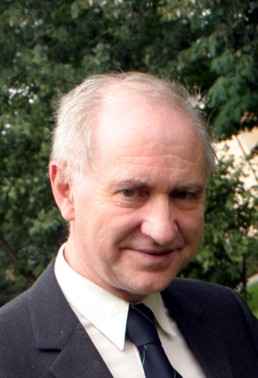
Jerzy Pikies (1946)
Head of Department of Inorganic Chemistry, 2003-2008
- Inorganic Chemistry and inorganic synthesis
- Chemistry of phosphoroorganic compounds
- Complexes of phosphanophosphinidenes with transition metals
Promoted doctors:
- dr inż. Jolanta Olkowska-Oetzel
- dr inż. Andrzej Robaszkiewicz
- dr inż. Wioleta Domańska-Babul
- dr inż. Rafał Grubba
- dr inż. Aleksandra Wiśniewska
References:
- O. Ruff: Chemiker Zeitung 9 (1905) 99
- W. Mizerski: Kurier Chemiczny 4 (1995) 28
- W. Hückel: Berichte 72 (1940) 125
- Praca zbiorowa: Technische Hochschule in Danzig, Festschrift zur Eröffnung, 6. Oktober 1904
- W. Klemm: Angew. Chem. 53 (1940) 25
- Praca zbiorowa: Beiträge und Dokumente zur Geschichte der TH Danzig 1904-45, Hannover 1979
- O. Ruff: Chemiker Zeitung 61 (1937) 6
- P. Karlson: Adolf Butenandt, Stuttgart 1990
- J. Goubeau: Angew. Chem. (1950) 179
- O. Glemser: Angew. Chem. 72 (1960) 179; Naturwiss. 47 (1960) 121
- W. Bronger: Journal of Less-Common Metals, 5 I 1981, IX
- R.O. Oesper: J. Chem. Educ. 29 (1952) 336
- J. Goubeau: Z. Elektrochem. 63 (1961) 105
- R. Hoppe: Z. anorg. allg. Chem. 622 (1996) 1
- W. Heisenberg: Część i całość, PIW 1987, str. 229
- M. Żydowo, W. Trzeciak: Doctorate h.c. reviews, archive TS
- Harenberg Lexikon der Nobelpreisträger, Dortmund 1998
- G. Rienäcker i in.: Z. anorg. allg. Chem. 279 (1955) 1
- T. Sokołowska: Pismo PG, 7 (1994) 7
- T. Sokołowska: Z Historii Politechniki Gdańskiej, 2 (1994) 4


